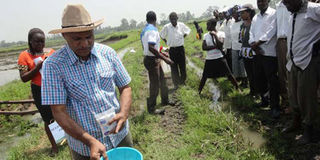Out goes paddy rice farming, in comes a new efficient method

Mr Kyshan Rao, an Indian engineer and farmer, shows farmers how to select good planting seeds in Ahero Irrigation Scheme, Kisumu County. PHOTO | ANITA CHEPKOECH
What you need to know:
- In Ahero and West Kano irrigation schemes, farmers are currently learning a new method of rice farming called Systems of Rice Intensification (SRI), introduced by the National Irrigation Board (NIB) in partnership with Ag SRI, an organisation from India.
- “Land is cleared of grass and bushes then flooded to soak and soften the soil for three to seven days. The farm is then ploughed and the soil mixed with water once again,” explains Prof Mati, adding the soil is then harrowed and levelled.
- With the seed verification method and transplant of only one seed per space, a farmer uses only 5kg of seeds per acre unlike the old method where one used up to 20kg on the same acreage.
- Speaking at Ahere this week, Prof Mati discouraged farmers from transplanting seedlings to a slightly flooded farm and then adding water continuously until the rice grows yellow.
Time seems to be up for paddy rice farming as researchers unveil a new method of growing the important cereal.
Paddy rice farming has been used across the country in areas where the crop is grown since 1963, when the grain was introduced to local farmers.
However, according to researchers, heavy water needed by the method amid low yields, increased diseases and declining soil fertility make paddy farming unsustainable.
In Ahero and West Kano irrigation schemes, farmers are currently learning a new method of rice farming called Systems of Rice Intensification (SRI), introduced by the National Irrigation Board (NIB) in partnership with Ag SRI, an organisation from India.
Bancy Mati, a professor of agriculture and a researcher at Jomo Kenyatta University of Agriculture and Technology, says land preparation for both traditional and SRI systems are the same, but in the latter, one uses less water.
“Land is cleared of grass and bushes then flooded to soak and soften the soil for three to seven days. The farm is then ploughed and the soil mixed with water once again,” explains Prof Mati, adding the soil is then harrowed and levelled.
Excess water is then drained to a porridge-like state before planting is done. Land preparation in rice farming is a tedious process that takes one week to 10 days to complete.
Another difference in the two methods comes in nurseries, whereby with paddy farming, seeds are planted under water while in SRI, seeds are place on raised seedbeds, which are watered sparingly.
“In the old method, seeds take 21 days to be transplanted but in SRI eight to 12 days. Again in SRI, a single seedling is transplanted at each space unlike the conventional method whereby farmers plant a handful of clustered seedlings.”
Kyshan Rao, an Indian farmer and engineer, says other than saving water, the method comes with a new high-yielding seed variety also called SRI.
“Before planting seeds, there is a way farmers can test their quality and ensure they plant the fully filled pods to prevent losses,” says Rao.
The test starts with putting water in a container and adding salt to make it dense.
“To know how much salt is required, an egg or a sizeable potato is dipped into the water. If the potato sinks, more salt is added and stirred until the potato floats,” he says.
The rice seeds are then poured into the water. Floating is an indication of poor quality seeds that should be thrown away.
The sunken ones are washed thoroughly to remove salt and spread sparsely in the raised seedbeds.
ONLY 5KG OF SEEDS PER ACRE
“This test assures the farmer that the seedlings will be of good quality which increases chances of a higher produce,” the engineer explains.
With the seed verification method and transplant of only one seed per space, a farmer uses only 5kg of seeds per acre unlike the old method where one used up to 20kg on the same acreage.
Prof Mati says the rice plant is a grass hence should be transplanted before the seed completely disappears to ensure healthy growth.
Transplanting rice seedlings early and carefully helps plants to resume their growth in the field without reducing their potential for high yields by harvest time.
“Rice is a water-loving plant, but it does not need to grow within water like it is swimming.”
Speaking at Ahere this week, Prof Mati discouraged farmers from transplanting seedlings to a slightly flooded farm and then adding water continuously until the rice grows yellow.
NIB regional manager Joel Tanui is optimistic the new method will increase production from two tonnes per acre to over four tonnes.
Tanui said when SRI is fully embraced, farmers in Ahero will now save up to Sh8 million in water alone annually.
Water has been the most expensive input in rice farming.
“Ahero Irrigation Scheme alone currently has an annual water bill of Sh18 million. Water is a very precious commodity and is a source of conflict in this region. With the new technology, we are aiming at cutting the amount of water used by 40 per cent,” he said, adding that the SRI variety was heavier with the usual 90kg bag weighing upto 110kg.
Other than Indian farmers coming to train Kenyan farmers, according to Tanui, the irrigation board is set to send a few of them to India to experience how the SRI system works and compare with what they are doing here locally.
“Since we started sensitising the farmers, they are very excited about SRI. But we will start with a pilot project involving about 100 farmers before rolling it out to the others.”





